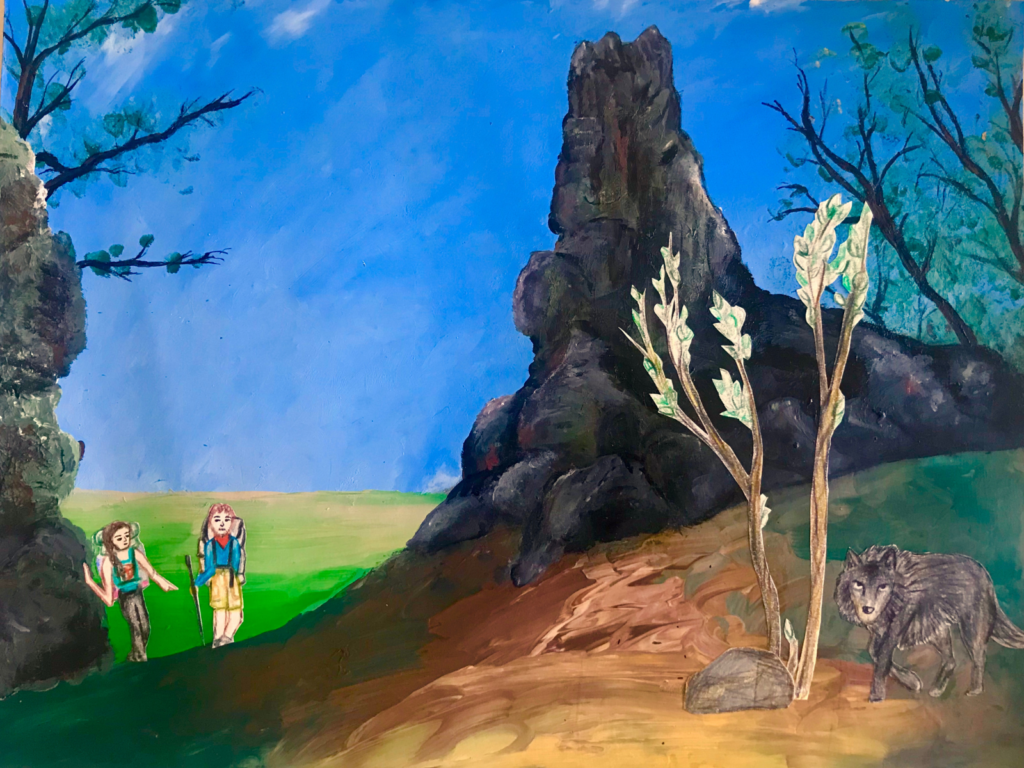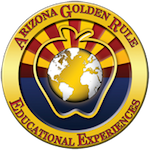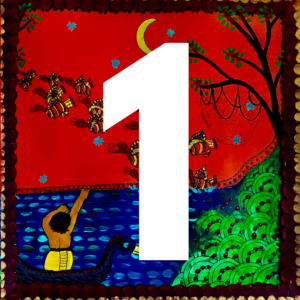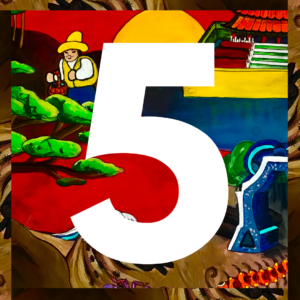“Stars Shine Brightly” is an arts resource, complete with world folk tales and original music, developed for grade levels K-5. Activities are for the classroom and include: Storytelling, Music, Dance, Theater, and Visual Art. “Stars Shine Brightly” is aligned with Arizona educational standards in ELA, World/Language, Arts; and Socio-Emotional competencies.

Third Grade Teacher Guides: Below are five sequential Third Grade cultural activities in Storytelling, Music, Theater, Dance, and Visual Art. Each activity begins with a group discussion (Prospecting for Gold) and ends with a class challenge (Golden Rule Challenge). As you use this resource in the classroom, your students will deepen their understanding of the Golden Rule, “Treating others the way they want to be treated,” through the life guiding principles of Kindness, Empathy, Respect, and Civility.
Arts Experience #1
Storytelling
AZ PO Strands
3.C1.2, 3.NF.A.3, 3.SL.1, COM.N.1
Golden Rule Focus
Students will talk about being under pressure and connect it with how they treat others.
Objectives
Civics (3.C1.2) Use listening, consensus-building, and voting procedures to decide on and take action in their classrooms.
Numbers/Operations (3.NF.A.3) Express whole numbers as fractions, and recognize fractions that are equivalent to whole numbers.
Speaking/Listening (3.SL.1) Participate in collaborative conversations with diverse partners and in small and larger groups. Follow agreed‐upon rules for discussions.
Communities (COM.N.1) Recognize a few letters or characters and learned words and phrases.
Materials
AGREE Resources:
AGREE Website Resources: Golden Rule Compass, “Two Hikers and the Wolf” Resource“, Civil Discussion
Additional Materials: Scrap paper (1 per student), 2 percussive instruments

Prospecting for Gold Consider rewarding students for their Golden Rule efforts by creating a jar for “gold nuggets” with a promised reward for filling it.
BEFORE YOU BEGIN…
Establish Civil Discussion in your classroom. The Civil Discussion guide uses the Golden Rule as an agreed upon standard of conduct that can be used to discuss a variety of topics (aligned with AZ State standard 1.SL.1-1.SL.5). To begin each Art Experience, use Civil Discussion guidelines while holding class discussions (“Prospecting for Gold”).
Prospecting for Gold: What does it mean to ‘live’ the Golden Rule?
Golden Rule Activity:
- “It’s time for a Golden Rule Experience! (Prospecting for Gold) What does it mean to ‘live’ the Golden Rule?“
- Explain that, “Today the class will be put under some pressure.” Let them know that, “Every day we are facing challenges and are under pressure. Today you will be given a simple challenge. After the challenge, we will share with each other how we felt during the challenge.”
- Pass out a piece of paper to each student then read the following instructions to your students without repeating.
- Fold your paper in half.
- Fold it in half again.
- And again.
- And again.
- And again.
- Without unfolding, rip it in half
- Ask the questions, “How did you feel when you were trying to rip the paper in half? How did you respond to the challenge? Did you notice how the people around you were responding?” (e.g., they were frustrated, they started moving quickly, I gave up).
- Optional: Have students unfold their paper and count the rectangles. Ask them how many rectangles are there total? How would we write 1 rectangle as a fraction of the whole? (1/32)
- “When we are under pressure, we start to break down a little, like a fraction. Parts of us get nervous, scared, frustrated, embarrassed, excited and sometimes we start treating people we care about differently.”
- Show the Golden Rule Compass and say, “When we are under pressure, it is important to navigate our feelings with the Golden Rule Compass.”
- On each 1/4 of the page, have students write each of the compass words:
- Kindness
- Empathy
- Respect
- Civility
Telling the Story:
- “This is a story set in a geographical area of the United States called Appalachia. In the story, two friends hiking the Appalachian Trail are put under pressure when they encounter a wolf. As we read the story, think about how you would respond if you saw a wolf and how you could use the Golden Rule Compass.”
- Choose two students to stand in front of the class, each receiving a percussive instrument. Assign one student the word “wolf” and the other student the word “friends” or “friend”. Every time they hear their word, they will make a sound on their instrument.
- Read or listen to “Two Hikers and the Wolf” with student instrumentation.
- Discuss, “How did the hikers respond under pressure?” (e.g., left their friend, panicked and ran, wanted to hide).
- Consider using the Golden Rule Compass & Puzzle to practice responding to different scenarios using the Golden Rule Compass words.
Golden Rule Activity Part 2
- “Everything that glitters is not gold,” is an expression from Appalachia and one way to interpret it is that things that seem amazing may not be as good as they appear.
- “Have you ever had a friend put you under pressure to do or say something hurtful? Is there ever a time when you might need to walk away from a friend?”
- “Sometimes we can work through hard times and differences! Especially with our best buddies.” Make a chart on the white board:
- Label one side “My Ideal Best Buddy Would…”
- Label the other side “My Ideal Best Buddy Would Not…”
- As a class list, ways you would or would not want a friend to treat you.
- Write the Golden Rule Challenge on the whiteboard or print to post and display it somewhere visible in the classroom. Read the Golden Rule Challenge as a class, “This will help you not only live the Golden Rule but also be a better friend!”
Golden Rule Challenge: I will treat others, especially my friends, the way I would want to be treated.
Arts Experience #2
Music
AZ PO Strands
3.MU.RE.3a, COM.N.1, 3.SL.1
Agree Strand
Students will share about things they like and discuss how to appreciate the differences in others.
Objectives
Music Creating (3.MU.CR.3a) Apply teacher-provided and collaboratively- developed criteria to evaluate and revise personal musical ideas.
Communities (COM.N.1) Recognize a few letters or characters and learned words and phrases.
Speaking/Listening (3.SL.1) Participate in collaborative conversations with diverse partners and in small and larger groups. Follow agreed‐upon rules for discussions.
Materials
AGREE Resources:
“How do ye call yer ole best Buddy?” Music Resources, Musical Instruments Visual Resource, “ya, yer, ole, ‘em” Audio Resource (on this page), “How do ye call yer ole best Buddy?” Lyrics Resource
Additional Materials: A map of the United States, (per student) writing utensil and paper
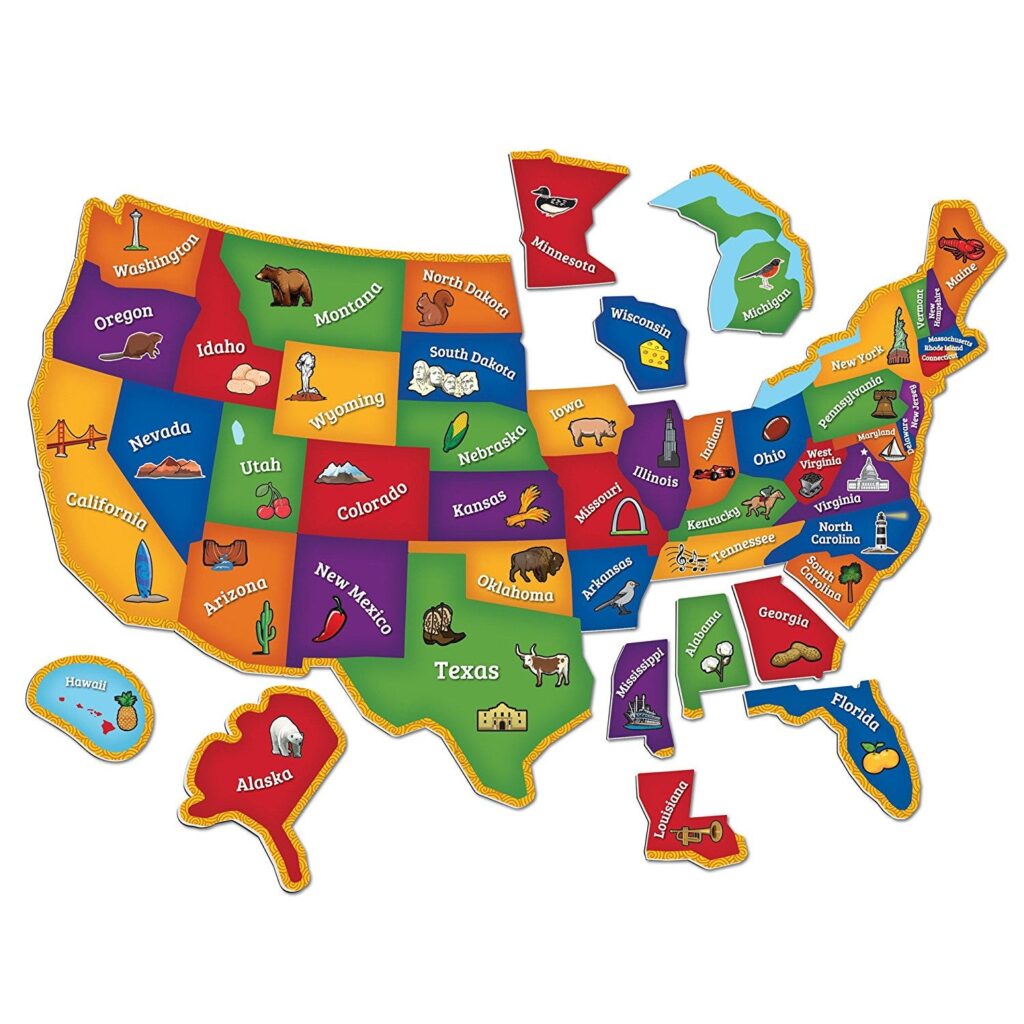
Prospecting for Gold: How have you been treating your friends?
Singing the Song:
- “It’s time for a Golden Rule Experience! (Prospecting for Gold) How have you been treating your friends?“
- “The song we will be learning was created by Arizonan as inspired by the bluegrass music. Musical instruments play a big part in determining the type of music it is.”
- Display the poster Musical Instruments Visual Resource of instruments. While listening to the first half of the song “How do ye call yer ole best Buddy?”, challenge students to identify and write down the names of the instruments that they hear in the song.
- After listening, invite students to share the instruments they heard. Instruments:
- tambourine
- guitar
- banjo
- violin
- Explain, “Another important part of this musical style are the lyrics. In this song you heard a dialect or abbreviated words.” Write the following words, have students say them out loud, and help figure out what they mean. Answers as follows:
- ya = you
- yer = your
- ole = old
- ‘em = them
- “These lyrics and this music style is probably different from the lyrics and music you normally listen to. What do you like about it? How is the music different?”
- “This song is about how we treat our friends.” Read the first verse and chorus of the song to your students, “How do ye call yer ole best Buddy?” Lyrics Resource. While reading, have them answer the following yes or no questions about how they treat their friends:
- When they’re hurtin’ do ya kick ‘em? NO.
- When they’re frightened to ya leave ‘em there? NO.
- When they’re cryin’ do ya tease ‘em? NO.
- What about when a wolf is there? Help them when it’s safe.
- Discuss with your students what a “wolf” could represent, “What are the different things that the “wolf” can represent /symbolize?” (e.g., a dangerous situation, getting in trouble, someone getting their feelings hurt, etc.).
- As a class, list ways that you can help someone who might be under pressure (e.g., acts of service, encouraging words, listen).
- Now play the second half of the song for your students and encourage them to clap, sing along and/or stand to get some wiggles out.
Golden Rule Challenge: I will be aware of how I treat my friends under pressure.
Arts Experience #3
Theater
AZ PO Strands
3.TH.CN.10a, 3.RL.3, 3.SL.1, COM.N.1
Golden Rule Focus
Students will identify aspects of their own culture and explore how to get along with people who are different than they are.
Objectives
Theater Connecting (3.TH.CN.10a) Use personal experiences and knowledge to make connections to community and culture in a theatrical work.
Reading Literature (3.RL.3) Describe characters in a story (e.g., their traits, motivations, or feelings) and explain how their actions contribute to the sequence of events.
Speaking/Listening (3.SL.1) Participate in collaborative conversations with diverse partners and in small and larger groups. Follow agreed‐upon rules for discussions.
Communities (COM.N.1)
Recognize a few letters or characters and learned words and phrases.
Materials
AGREE Website Resources: “A Hiking Tale on the Appalachian Trail” Script Resource, “Mad as a wet hen” Audio Resource (on this page)
Materials: Printed scripts, Paper, Drawing Tools
Prospecting for Gold: Have you been a friend to someone under pressure lately? What happened?
Golden Rule Activity:
- “It’s time for a Golden Rule Experience! (Prospecting for Gold) Have you been a friend to someone under pressure lately? What happened?“
- Start a discussion by asking, “Ever felt “Mad as a wet hen” (really mad/angry) when someone does something that makes things more difficult or messes with your idea of how something should be done?
- “We all have different ways of doing things and need to learn to Respect our differences.”
- “Describe your own culture.” Write these prompts on the board and have your students respond by writing and drawing images of their answers.
- Food I eat
- Celebrations with my family
- Language I speak at home
- Once they have had time to draw a few things, divide students into small groups. Have students take turns sharing about what they drew with each other. Instruct groups to:
- Identify one thing all have in common
- Identify three to four things that are different
Reading the Script:
- “In the script we will be reading, each hiker has a slightly different cultural background, just like all of us, including different food preferences and family relations. In this script, each hiker responds differently to meeting a wolf on the trail.”
- Print and distribute the script to students “A Hiking Tale on the Appalachian Trail” Reading Resource. Assign students parts to read, preferably strong readers for the hiker roles. Encourage them to speak loudly and clearly as they read through the script.
- After reading through the script, ask the following questions:
- What choices did the first set of hikers make? (e.g., run away, stand still, brought sugary foods, etc.)
- What choices did the second set of hikers make? (e.g., did not bring enough water, help each other, etc.)
- How could our differences (unique backgrounds and cultures) help in situations like this?
- Write the Golden Rule Challenge on the whiteboard or print to post and display it somewhere visible in the classroom. Read the Golden Rule Challenge as a class, “When I am with people who act differently than I do, I’ll listen, learn, and try to understand them.”
Golden Rule Challenge: When I am with people who act differently than I do, I’ll listen, learn, and try to understand them.
Arts Experience #4
Dance
AZ PO Strands
3.DA.PR.5c, 3.SL.1, COM.N.1
Golden Rule Focus
Students will discuss and consider treating each person they meet as a possible friend.
Objectives
Dance Presenting (3.DA.PR.5c) Move safely in a variety of spatial relationships and formations with other dancers, sharing and maintaining personal space.
Speaking/Listening (3.SL.1) Participate in collaborative conversations with diverse partners and in small and larger groups. Follow agreed‐upon rules for discussions.
Communities (COM.N.1) Recognize a few letters or characters and learned words and phrases.
Materials
AGREE Resources:
“Happy as a little pig in a mud puddle” Audio Resource (on this page), “Friendship Contra Dance” Video Resource, “How do ye call yer ole Best Buddy?” Music Resource
Prospecting for Gold: What are some advantages of getting to know people who are different from you?
Doing the Dance:
- “It’s time for a Golden Rule Experience! (Prospecting for Gold) What are some advantages of getting to know people who are different from you?”
- “Contra Dancing is a way for us to dance together and feel, “Happy as a little pig in a mud puddle” (aka really happy). Popular in the Appalachian Region, it requires everyone to move in intricate patterns as a group.”
- “As a class, we will be learning how to do the Friendship Contra Dance. It is similar to a popular dance called the Virginia Reel. Treat and greet each person with Respect. Smiling and showing them appreciation.”
- Organize students into groups of six. Within each group, have them stand in two lines facing a partner. Encourage them to partner with someone they do not normally spend time with (“How do ye call yer ole Best Buddy?” Music Resource).
- Pick one end of the lines to be the “Top partners” for each group. You will be acting as the “Caller” by saying the following:
- Call 1: “Wave to your partner and say howdy partner!”
- Call 2: When singing begins, “Walk forward to partner and give them a high five, walk backwards to where you started and clap twice.” (8 counts)
- Call 3: “Walk forward to partner, high five, walk back and clap twice.” (8 counts)
- Call 4: “Walk forward and Right arm turn with your partner. Clap clap.” (8 counts)
- Right Arm Turn: Right arms link and partners turn around each other till they get back to their beginning spot facing partner.
- Call 5: “Walk forward and Left arm turn with your partner. Clap clap.” (8 counts + slight pause)
- Left Arm Turn: Left arms link and partners turn around each other till they get back to their beginning spot facing partner.
- Call 6: “Top Partners, grab hands and walk down the center of the group and everyone else follow with your partner.”
- Call 7: “Follow the ‘top partner’ from your line, peeling out like a banana, and walking around the backside of your line till you find your partner again.” (8 counts)
- Call 8: “Once you get back to where you started, Top Partners put hands together and everyone else walk under with your partner.”
- Call 9: “Stay in order and form the two original lines again. Once everyone goes under, Top Partners walk around the backside of the lines as the dance begins again and join the dance at the bottom of the lines. There is now a set of new “Top Partners.”
- Call steps 1 through 9 two more times. At the end of the song, students will repeat steps 1 through 6 one more time and bow/curtsey to their partner.
- This dance can get tricky and may need to be repeated multiple times to understand the movement patterns. Practice several times and have students switch partners. Use the “Friendship Contra Dance” Video Resource to assist in teaching the dance.
- Write the Golden Rule Challenge on the whiteboard or print to post and display it somewhere visible in the classroom. Read the Golden Rule Challenge as a class, “I treat everyone I meet with the same respect I want to receive.”
Golden Rule Challenge: I treat everyone I meet with the same respect I want to receive.
Arts Experience #5
Visual Art
AZ PO Strand
VA.PR.5a, 3.SL.1
Golden Rule Focus
Students will create together while being open to the differences of others and illustrating what friendship looks like.
Objectives
Visual Art Objective: (VA.PR.5a) Identify appropriate exhibit space and prepare works of art for presentation (e.g., counter space, bulletin board, display case, media center) and write an artistic statement (e.g., descriptive sentence).
Speaking/Listening (3.SL.1) Participate in collaborative conversations with diverse partners and in small and larger groups. Follow agreed‐upon rules for discussions.
Materials
AGREE Website Resources: Quilt Frame Print Resource (colored paper), Quilt Strips Print Resource (white paper)
Additional Materials (per student): Watercolor paint, Coloring supplies, scissors, glue

Prospecting for Gold: Is there a limit to how many friends you can have? Why or why not?
Creating the Art:
- “It’s time for a Golden Rule Experience! (Prospecting for Gold) Is there a limit to how many friends you can have? Why or why not?”
- “Friendship can be like a warm quilt during cold times.” Explain that you will be making friendship quilts, which will require everyone to both give to and receive from others.
- “We can buy blankets and quilts at the store with all new materials. In the past, people would cut up their old clothing that was worn out or no longer fit, and sew the pieces together to make quilts. Often groups, made up of friends or family, would work together to make one. If you received a quilt, it was a symbol of friendship made by people who cared and spent a lot of time working on something just for you.”
- Each student will need a printed “Quilt Strips” Print Resource and a printed “Quilt Frame” Print Resource.
- Have your students use watercolors to paint strokes on the “Quilt Strips” paper. Encourage them to represent old faded clothing, dark in some areas and light in others.
- Have students cut along the dotted lines “Quilt Frame.” Be careful to leave the edges intact, not cutting all the way across.
- Once the “Quilt Strips” are dry, have students cut along the dotted lines.
- Instruct students to write their name on the back of each strip of paper. Have them choose one to keep and put the other strips into a large pile with the other students.
- Collect the strips and then redistribute them to your class (two per student).
- After they’ve been passed out (be careful not to give students their own), have students weave the strips into the “Quilt Frame” with varying patterns:
- Strip 1: over, under, over, under, over
- Strip 2: under, over, under, over, under
- Strip 1: over, under, over, under, over
- Glue the ends of the strips to the quilt frame.
- Invite students to decorate each part of their quilt’s “blocks” using markers/crayons, illustrating or adding words of things that they think are important to show and do as a friend.
- Write the Golden Rule Challenge on the whiteboard or print to post and display it somewhere visible in the classroom. Read the Golden Rule Challenge as a class, “Being open to sharing with others will help me feel happy and make more friends.”
Golden Rule Challenge: Being open to sharing with others will help me feel happy and make more friends.
Bulletin Board Idea: Create a bulletin board with a solid color to display the students’ quilts. Place the quilts close together to give the impression of one big quilt. As a class, when acts of friendship are displayed, individuals can add images to the class quilt or around the quilt, that illustrate the acts of friendship (e.g., two kids sharing, laughing together, playing together). This can be used to encourage friendly behaviors in your classroom.
